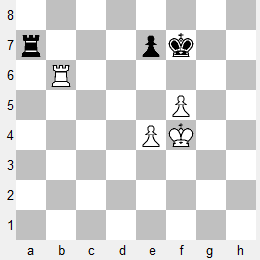An Important Seven-piece Endgame
Continuing with the Seven-piece Tablebase on Lichess (August 2018), I first looked at endgames of Q+2P vs. Q+P in A Flawed Seven-piece Study (ditto):-
The next section in Averbakh's book covers Q+2P:Q+P where the strong side has a passed Pawn. I fed all six examples to the Lichess tablebase and discovered that Averbakh's analysis was correct on five of them.
I then turned my attention to R+2P:R+P. Before tackling Averbakh, I decided to return to 'Rook Endings' by Levenfish and Smyslov, previously seen on this blog in Levenfish's Rook Endings (January 2011) and The Bridge, the Diversion, and the Best Defense (November 2011). The authors introduced the section titled 'Rook and Two v. Rook and One' with:-
This section is of great practical interest, as endings of this type, quite naturally, arise very often: as when one player has won a pawn during the game but at the same time most of the pawns have been exchanged off. As is clear from previous chapters, a R + P v. R ending is by no means always won for the superior side. The situation becomes more complicated with the addition of an extra pawn on each side, as this allows for new resources both for the attack and for the defence.
For example, the superior side can sometimes reduce to an ending with two far advanced connected pawns against a rook, whilst the defending side can sometimes reduce to an ending with rook v. far advanced pawn. Sometimes the defending side manages to transpose into a drawn ending with R + 2P v. R of the type analysed in Chapter 3.
No less important is the fact that, in analysing more complex rook endings, positions with two pawns v. one pawn can come up. Only if these positions are correctly appraised can the correct way to solving the more complex endings be found. But up till now endings with R + 2P v. R + P have been very poorly dealt with in chess literature.
The section is separated into positions having similar characteristics in their Pawn structure. The first diagrams in the section are of the type that is easiest to assess.
When the pawns are opposite each other and the superior side does not have a passed pawn, the result is usually a draw.
For example, the first position is shown in the following diagram.

White can make no progress: 1.Rh6 Ra4 2.Rh7+ Kf6 3.Rh6+ Kf7 4.Re6 Rb4 5.Kg5 Ra4 6.e5 Ra5. The position after the third move repeats the position after the first move, probably to show two different tries by White.
Despite the supposed simplicity of the other examples, I discovered a number of inaccuracies in their analysis. I'll discuss one or two of them in a future post.




No comments:
Post a Comment